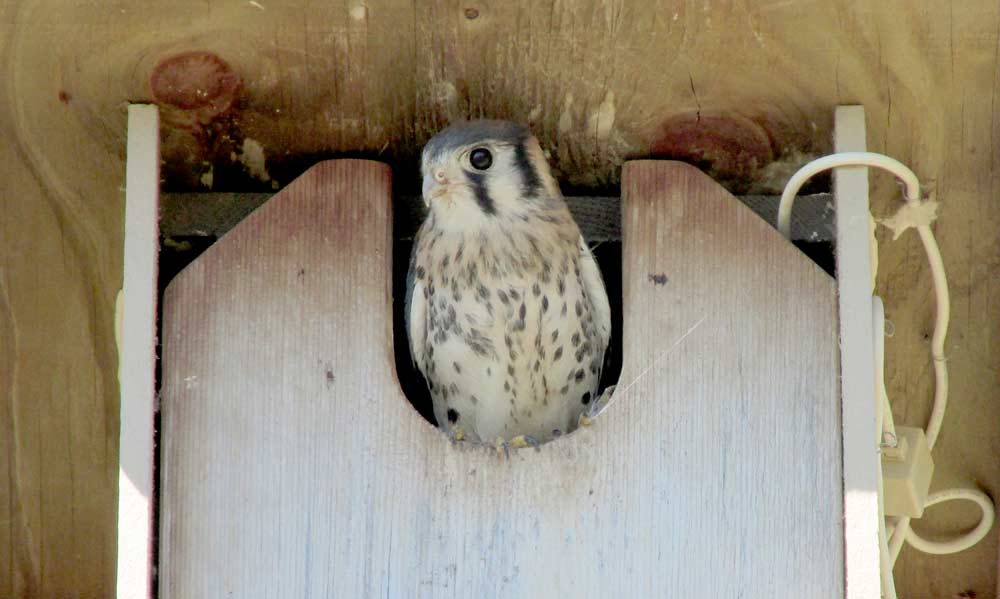
A fledgling kestrel peaks out of a Michigan State University nest box. Two MSU researchers are expanding their investigation of pest-management decision-making by conducting a survey of blueberry and cherry growers across the United States. The survey comprises general questions about which pest-management practices growers currently use and their expectations of consequences arising from various pest-related scenarios. It also includes a brief summary of new research findings relating to the ecological and economic benefits of kestrel nest boxes, followed by questions asking growers’ thoughts about adopting the practice. (Courtesy Megan Shave)
How do growers decide whether to implement nonchemical, so-called “cultural,” pest control practices?
A new Michigan State University study of blueberry and cherry growers shows that they tend to take the same types of things into account, regardless of whether they have large or small farms, or use traditional or organic practices.
In this study, Phil Howard and doctoral student Chris Bardenhagen of MSU’s Department of Community Sustainability centered on growers’ responses to bird damage, which can be quite extensive in these two crops. Howard notes that annual, bird-related harvest losses in Michigan total $14.1 million in blueberries, $2.2 million in tart cherries, and $2.1 million in sweet cherries.

Chris Bardenhagen
To learn more about the decision-making process, the researchers last fall interviewed 34 Michigan cherry and blueberry growers representing a variety of farm sizes and approaches.
They found that the desires for good fruit quality, low pest-control costs and reduced pest pressure all carried weight in any decisions about pest control, including pesticide use.
Timing, however, was a key factor in farmers’ thinking processes and can affect the implementation of a cultural practice, such as stringing up bird netting, firing loud cannons or live ammunition to frighten birds away, installing inflatable tube dancers or other visual-scare devices or using nest boxes to attract small predatory falcons, known as American kestrels, that prey on fruit-eating birds.
“What that tells us is that cultural practices that fit well within the farming calendar may be the bigger winners for growers,” Bardenhagen said.
As an example of timing, Howard points to kestrel nest boxes. The labor needed for the nest boxes, which includes installing them before the birds’ spring nesting activities and cleaning them out afterward, can be done during slow periods on blueberry and cherry farms.
Kestrel nest boxes, however, are a better fit for cherry orchards, because kestrels are nesting at about the same time that fruit-eating birds are descending on cherries, he says. With some blueberry varieties, however, the peak of bird damage may not come until kestrels have finished nesting and move on.
The two researchers are now expanding their investigation of pest-management decision-making by conducting a survey of blueberry and cherry growers across the United States.
The survey comprises general questions about which pest-management practices growers currently use and their expectations of consequences arising from various pest-related scenarios.
It also includes a brief summary of new research findings relating to the ecological and economic benefits of kestrel nest boxes, followed by questions asking growers’ thoughts about adopting the practice.
Bardenhagen began distributing the survey to industry groups in February and hopes to begin analyzing responses later this year.

Phil Howard
“So far, a number of studies have shown what growers are doing in terms of pest management, but they haven’t really looked at why growers choose certain practices and not others,” Howard said. “With this bottom-up approach, we’re hoping to understand the factors involved, as well as farmers’ perspectives on pest-management decisions.”
In addition, these findings may help researchers communicate better with growers, he said.
“We expect our results to help people who are researching pest-management practices to be able to share the results in ways that are most relevant for farmers. For example, our preliminary research suggests that timing is a key variable that farmers consider, so knowing the timing of a practice — and how it would affect other practices — is important information to include, in addition to more well-known factors such as costs and potential impacts on yield.” •
—by Leslie Mertz






Leave A Comment